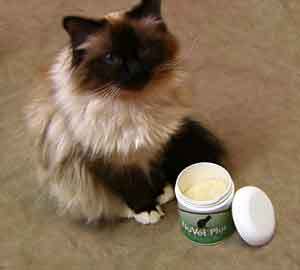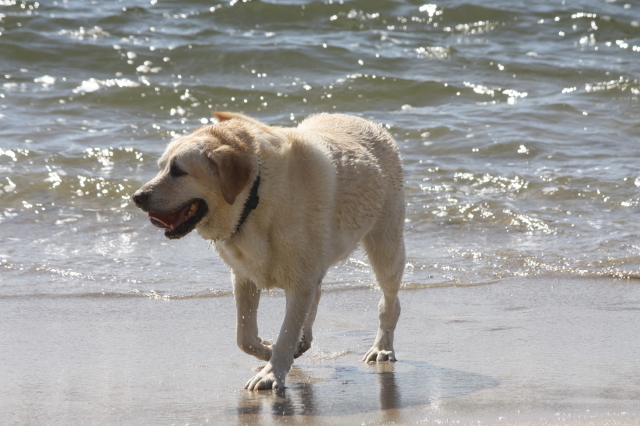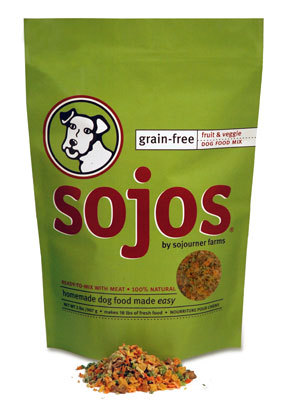Question-------------------------
Followup To
Question -
My two, two year old labrador deciever females (sisters)have small amounts of green goop oozing from the corners of their left eye. Each dog has this only in one eye, one is worrying it the other is not. they are about 70 lbs each and otherwise healthy, all shots up to date etc.
Please help.
Mark
Answer -
Hello Mark -
A few questions to you:
Do the dogs itch their eyes?
Does the "goop" have an odor?
How long has the "goop" been appearing?
Is the eye itself inflammed, have a shadow like image or have a thick mucous like crust over the eyeball?
Please answer the best you can and I will get back to you with a response.
Thanks
Sharon Hubbs, AHG
Certified Natural Health Consultant & Herbalist
The dogs are occaisionally itching their eyes
The goop has no discerable odor,(I don't have a very sensitve nose)
We are on day 4 of goopage
I see no inflamation around the eye, no shadow, and no mucous crust
AnswerHello Mark -
This sounds like a condition called Pannus. Pannus is an immune mediated corneal disease primarily found in the German Shepard breed although other predisposed breeds include Greyhounds, Huskies,Dachshunds and Labrador Retrievers. Ultraviolet light and altitude influence the severity of the disease. Pannus is a progressive, non painful, inflammatory disease of the cornea, conjunctiva, and sometimes the third eyelids (when affecting the third eyelid, it is termed "atypical pannus" or "plasmoma"). Other breeds reported to have problems with pannus include Poodles, and Border Collies. Variable proportions of pigmentation, corneal vascularization, granulation tissue, and cholesterol deposits characterize Pannus. The corneal changes usually begin on the lower outside surface of the eye. Both eyes are affected, though the diseased regions may be asymmetric. Some dogs also have dry eye problems. As the disease progresses, blindness can develop. The cause of Pannus is not well understood, but several factors are involved: The breed incidence suggests a heritable predisposition. Additionally, UV (ultraviolet) radiation plays an important role as an inciting and propagating factor. Dogs living at high altitudes and low altitudes are more severely affected. Also, auto immunity and possibly genetics play a part. Since the 2 dogs you have are sisters, heredity may play a role here.
Keep an eye on this as symptoms may progress. I am not 100% certain that this is Pannus but the symptoms sound on the money. Your pets may also have an allergy or a localized infection, I cannot be sure without seeing them.
I recommend taking them to a vet specializing in eye care. They will administer steroid drops for you to put into the eye. This is a life long process should it be Pannus. If symtpoms do not decrease some vets will perform a surgery on the cornea. In time a small corneal ulcer may develop and the animal will lose the ability to see.
For the meantime, keep the eye wiped clean. If you are familiar with herbs, I recommend making a tincture of Eyebright. This herb will help cleanse the eye area and fight infection should there be one present. You can purchase Eyebright from local herb shops or order it online. It is very easy to make and 1 ounce of this will last quite a while. Simply add 1 (one) tablespoon to 24 oz (3 glasses) of water and boil heavily. The water will turn yellow to light brown. Strain the herbs and keep the tincture in a glass jar. Use a clean cotton ball on the eye for every application. Apply this 3-4 times per day. Don't be afraid to get this into the dogs eyes, it will not hurt it. Administer a few direct drops. Eyebright will help soothe, comfort and lubricate the eye membranes. You could use this on yourself as well if you suffer from hayfever, allergies or have a bad cold. I could send you an ounce of Eyebright, it would be $3.00 including shipping, if you were interested.
In addition, I suggest adding a Vitamin A supplement to the dogs diet. A daily recommended dosage to be added to their food per dog is 700 ug or 2330 IU. Vitamin A helps regulate the immune system. The immune system helps prevent or fight off infections by making white blood cells that destroy harmful bacteria and viruses.It helps maintain the surface linings of the eyes and the respiratory, urinary, and intestinal tracts. When those linings break down, bacteria can enter the body and cause infection. Vitamin A also helps maintain the integrity of skin and mucous membranes. At least 3 million children develop xeropthalmia, damage to the cornea of the eye, and 250,000 to 500,000 go blind each year from a deficiency of vitamin A. Most of these children live in developing countries. Night blindness is one of the first signs of vitamin A deficiency. In ancient Egypt it was known that night blindness could be cured by eating liver, which was later found to be a rich source of vitamin A. Vitamin A deficiency contributes to blindness by making the cornea very dry and promoting damage to the retina and cornea. Studies have been done on dogs and have had high results from adding Vitamin A to the diet.
Also, do not expose the dogs to high UV light ie: bright sunlight and snow as it will irritate the eye. Wash your hand frequently when touching the dogs eye area. Keratitis (pannus) can occur in humans as well.
I hope this information helps you with your pets. If you are interested in natural remedies or herbal remedies please contact me at wintersaurora@yahoo.com and I will be happy to put a catalog in the mail to you.
Best wishes to you and your pets. If you have any other questions, please contact me and I will happy to help you answer them.
Thank you
Sincerely,
Sharon Hubbs, AHG
Certified Natural Health Consultant & Herbalist

 diet and homeopathy for kidney failure canine ; nuvet for kideny ; cranberry canine dosage ;
QuestionQUESTION: I am looking for homeopathic or chine
diet and homeopathy for kidney failure canine ; nuvet for kideny ; cranberry canine dosage ;
QuestionQUESTION: I am looking for homeopathic or chine
 deworming / vaccines for a 5 1/2 week old puppy
QuestionQUESTION: Hi, we are about to get a Soft-
deworming / vaccines for a 5 1/2 week old puppy
QuestionQUESTION: Hi, we are about to get a Soft-
 12 year old lab w/ torn ACL; acl alternatives to sugery ; NuJoint ACL canine :
Question
Truman
Hi Marie. My sweet old timer, Tru
12 year old lab w/ torn ACL; acl alternatives to sugery ; NuJoint ACL canine :
Question
Truman
Hi Marie. My sweet old timer, Tru
 severe itching and scratching due to allergy; steroids boston terrier;
QuestionOur three-year-old female Boston terrier has a
severe itching and scratching due to allergy; steroids boston terrier;
QuestionOur three-year-old female Boston terrier has a
 cat with runny nose
QuestionA stray cat has taken up living with us. Shes a
cat with runny nose
QuestionA stray cat has taken up living with us. Shes a